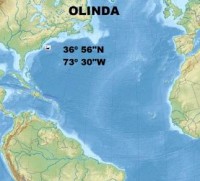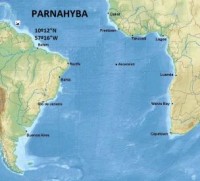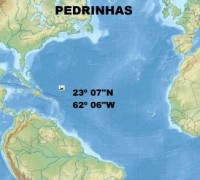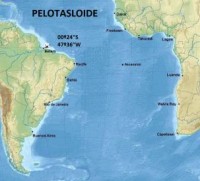SHIPS HIT BRAZIL 33 - BRAZILIAN SHIPS LOST
25)OZÓRIO U-514
.jpg)

Photo: https://upload.wikimedia.org/wikipedia/commons/6/6c/Osorio_ex_lake_elkwater.jpg

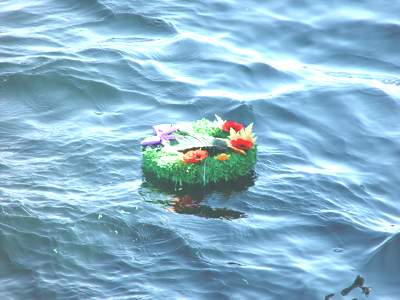
Built: 1919
Tonnage: 2,731 tons
Cargo: N/A
Route. Belém, Pará - Port of Spain, Trinidad - New York
Sunk 28 SEP 42 by U-514 on pos 00º03"N 47º45"W
5 Dead
34 Survivors
Until merchant Navy Convoy system was established in South Atlantic, Brazilian Navy still suffered several losses. Nothing less than 13 units were attacked and sunk by the U-boats. Five out of these 13 occurred throughout second semester of 1942, “the crucial year of the War”. The last 8 during 1943. The first occurred at September 27th 1942, against 2 merchantmen which plied the waters among a convoy of 4 units escorted by American destroyer DD 418 Roe. In this day merchants Osorio and Lages were sacrificed in a lapse of a few minutes.
Merchant Ozorio was a Brazilian Lloyd cargo ship, ex Lake Elkwater, acquired with 13 other from Mc Cormack in 1940. Had a displacement of 2731 tons of registry and was built in 1919.She was torpedoed at 08:10 PM, at estimated position N 00º03’ W 47º45’, when sailing from Belem to New York under master Almiro Galdino.
The ship was hit by one torpedo at # 3 hold that destroyed all the lifeboats located at that point. The same happened with those located portside once the davits were damaged by debris. In the imminence of submersion, master Galdino ordered to abandon ship. One single lifeboat managed to be lowered and one more raft where survivors were settled. Before the doomed ship plummeted one small vessel was sighted with a searchlight at her topmast. She got closer to the ships portside and spotted her with the searchlight.
In that chaos, the survivors were not able to be certified on the whereabouts of his master; therefore some crewmen admitted that he and the radioman had been taken in captivity by the attacking sub. Then, the merchant already listing badly portside, heeled over and plunged in 25 minutes of agony. To the survivors was not possible due to darkness any possibility to identify the aggressor, which limited his action by only one torpedo launched.
Destroyer Roe soon set for the scene of disaster and remained there until the rescue procedures were completed. The lifeboat cramped with almost 20 men rescued 15 more from the raft and with 35 souls they rigged a sail with blankets and took the course for the deserted coast of the State of Para. In the first hours of the morning of 29th, survivors sighted the Maguary lightship at Marajo island and were rescued by the sailing ship Concordia that landed them at village of Mosqueiro. 35 crewmen out of 39 were saved, although one of them came to die during that day in consequence of the wounds he suffered during the sinking.
From Mosqueiro they were taken to Belem by the tug boat Almirante Alexandrino from Administration of the Port of Para. Master Galdino was one more loss to be lamented. On 8 Jun 1942, the Ozório rescued eleven survivors from a lifeboat of Robin Moor in 00°16N/37°37W and landed them at Recife, Brazil. In June 8th 1942 Merchant Osorio fished out some survivors of American steamer Robin Moor, torpedoed May 21st. Two crewmen of that ship, Phil Richards and John Barringan got adrift for 895 miles before being sighted by Osorio.
This fact caused deep impact on the Brazilian Merchant crewmen for the fact that the lack of any survival kit available. When ashore, they decided to publish a handbook titled “How to abandon a Ship” that turned out to be a best seller for merchant sailors at that times. In it, several suggestions were highlighted concerning the salvage gear, rescue boats, etc. There were also, serious comments on the pressing allocation of an emergency budget to be invested in safety that would result in the difference between a forgotten hero sinking in 1942 or a happy veteran in 1945.
One more important topic discussed in the handbook was the fact that most ships tended to provide unnecessary comfort like pools, Movie Theater, luxurious decoration but in other hand completely neglected the primary safety measures which could mean lives saved in a disaster. They strongly advocated with the engineers, a better and more functional construction blueprints, with more adequate water tight compartments which could preclude an immediate ship’s listing due to a torpedo hit. This would avoid widespread panic among the crew in charge of lowering the lifeboats.
Many were the precious losses of life in so many sinkings, caused by the confusion created by the emergency itself and much more acute when it happened at night. On the wake of the success the handbook made, several new devices were soon launched such as appropriate rations, medicines, inflatable rafts with cover against the sun, cold and winds.
